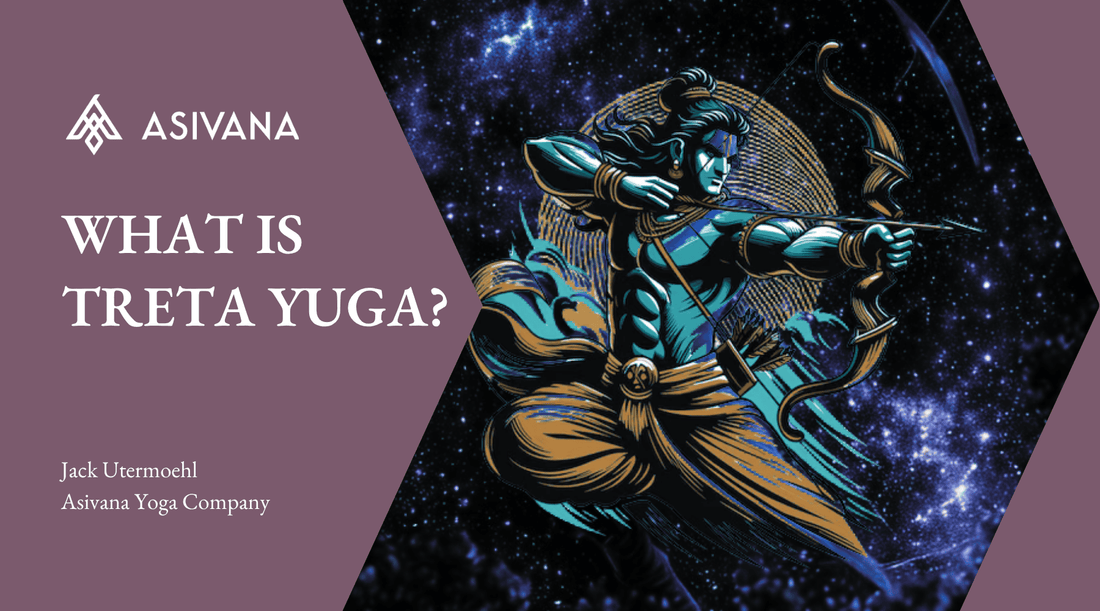
What is the Treta Yuga?
Jack UtermoehlShare
Treta Yuga is the second of the four ages in the traditional Hindu cycle of time known as the Chaturyuga. Following the golden age of Satya Yuga, it represents the beginning of moral and spiritual decline in the cosmic timeline.
While virtue still dominates, it no longer stands in perfect balance.
Often called the “Silver Age,” Treta Yuga is known for great advances in civilization, epic incarnations of Vishnu, and the rise of structured spiritual practice, especially yajna (ritual sacrifice).
This age is home to the legends of the Ramayana and marks the time when Dharma (cosmic order) begins to lose one of its four supporting pillars.
Etymology and Meaning
- Sanskrit: त्रेता युग (Treta Yuga)
- Transliteration: Treta Yuga
- Phonetic Pronunciation: TRAY-tah YOO-guh
- Root Meaning: Treta means “three,” referring to the fact that Dharma now stands on only three of its four legs, Satya (truth), Sauca (purity), and Daya (compassion) remain, while austerity begins to fade.
Treta Yuga symbolizes a world where goodness still prevails but is no longer effortless. People must strive toward virtue through conscious effort and organized rituals.
This age also introduces kingship, governance, and social structures that reflect the descent from pure spiritual harmony into duality and responsibility.

Explore Our Full Collection
Discover all the yoga essentials and accessories you need to enhance your practice. Shop now and elevate your yoga practice.
Shop NowDuration and Timing
| Tradition | Duration | Details |
|---|---|---|
| Puranic (Classical Hinduism) | 1,296,000 earth years | 3,600 divine years × 360 = 1,296,000 earth years |
| Sri Yukteswar's Interpretation | 3,600 earth years | Part of the 24,000-year Yuga Cycle (Descending & Ascending) |
Date Ranges
Traditional View: Treta Yuga follows Satya Yuga and precedes Dvapara Yuga. According to classical timelines, it began approximately 3.9 million years ago.
Yukteswar’s View: The most recent Treta Yuga ended around 6700 BCE. The next Ascending Treta Yuga will begin around 5700 CE.
Scriptural Source References
Ramayana (Valmiki): The entirety of the Ramayana epic unfolds during Treta Yuga, centered on the life and mission of Lord Rama who is upholding Dharma as an ideal king and avatar of Vishnu.
Mahabharata (Shanti Parva): Refers to Treta Yuga as an age when virtue begins to decline and righteousness must be actively maintained through sacrifice and duty.
Vishnu Purana (Book I): Describes the gradual weakening of Dharma as it stands on three legs, with spiritual discipline requiring ritual effort.
Bhagavata Purana (12.3.19): States that yajna (sacrifice) is the primary dharma in Treta Yuga, and that people begin to identify with ego and separate identities.
"In Treta Yuga, men performed sacrifices for the gods. Righteousness waned slightly, but truth, purity, and compassion still upheld the world."
– Vishnu Purana
Defining Characteristics of the Age
Treta Yuga marks the beginning of the gradual decline from perfect harmony. There is a subtle yet noticeable shift in human consciousness and morality during this age.
| Aspect | Treta Yuga |
|---|---|
| Human Lifespan | Up to 10,000 years |
| Moral State | 75% of Dharma remains; ego and ambition begin to influence behavior |
| Behavior | Truth still valued, but pride, desire, and comparison begin to emerge |
| Society | Emergence of caste system, kingship, social structure, and rituals |
| Technology & Knowledge | Yajnas (sacrifices) and formalized rituals introduced; scriptural study begins |
| Symbolic Dharma Bull | Stands on three legs, indicating the first loss of balance in cosmic order |
Treta Yuga introduces moral complexity. People still aspired toward righteousness, but external forms of discipline and religious practice became necessary to uphold what was once innate.
Authority figures and societal roles emerged to guide and preserve Dharma.
Spiritual Practice of the Yuga
In Treta Yuga, the recommended path to spiritual growth was yajna. Humans were no longer fully pure in nature, and thus the fire ritual became the sacred act that maintained alignment with the divine.
Primary Practice: Fire sacrifices to devas, conducted with precise ritual and intention
Yogic Emphasis: Karma Yoga (yoga of action) and Bhakti Yoga (devotion)
Role of Priesthood: Emergence of Brahmins and Vedic rituals to maintain cosmic harmony
Spiritual Tone: Discipline, devotion, and duty became the guiding virtues
Comparison of Yuga Practices
- Satya Yuga: Meditation and self-realization
- Treta Yuga: Yajña (fire sacrifice) and ritual worship
- Dvapara Yuga: Temple worship and scriptural study
- Kali Yuga: Chanting the Divine Name (Hari Nama)
Yajna in this age was not only about offerings to the gods, but a symbol of inner discipline.
Every act became a sacrifice of ahamkara (ego), a means to remember that righteousness requires effort as Dharma becomes less stable in the world.
Avatars of Vishnu in This Age
Treta Yuga is most famously associated with one of the most beloved incarnations of Vishnu, Lord Rama.
Avatar: Rama (the righteous prince and king)
Role: Ideal human, restorer of Dharma, embodiment of virtue and sacrifice
Symbolic Function: Rama exemplifies the perfect adherence to duty (dharma), moral strength, and devotion in the face of adversity
Through the story of the Ramayana, Rama’s life becomes the archetype for righteous living in a time where Dharma must be consciously upheld through action.
His commitment to truth, loyalty to family, and resistance to temptation reflect the values required in Treta Yuga’s more complex moral landscape.
Modern Interpretations
Contemporary spiritual teachers often refer to Treta Yuga as the age where conscious effort and devotion must replace natural purity. The loss of one leg of Dharma marks the beginning of individual responsibility for upholding spiritual values.
Sri Yukteswar & Yogananda
According to Sri Yukteswar's 24,000-year cycle, Treta Yuga is a descending age of reason, where intellectual development and devotion co-exist. Yogananda emphasized Rama as a symbol of living dharma, not just myth but a living standard for all seekers.
Sadhguru
Sadhguru describes Treta Yuga as the stage where discipline, loyalty, and commitment must be intentionally cultivated. The divine is no longer fully present in everyone, so devotion becomes a way to reconnect.
Symbolic and Archetypal Views
In archetypal terms, Treta Yuga represents the emergence of the "Hero’s Journey", the need to take the call-to-action and step out of innocence to make conscious moral choices. It is the age of sacrifice, where inner peace must be forged through outer tests.
Relevance for Today
While Treta Yuga lies in the distant past, its themes are powerfully relevant in the modern age. It reflects a world where inner purity is no longer guaranteed, and spiritual practice requires dedication, ritual, and conscious effort.
For yoga practitioners and seekers, Treta Yuga offers a reminder that righteousness is no longer effortless but rather it must be cultivated through tapas (austerity), bhakti (devotion), and commitment to dharma.
We may no longer live in an age where yajnas are literal fires, but symbolic sacrifice is still essential: surrendering ego, desires, and comfort to align with something higher. The spirit of Treta Yuga calls for right action even when it is hard, and devotion even in the face of doubt.
Reflection prompts:
- What sacrifices do you make to live in alignment with your true values?
- Where does your life reflect Rama’s example of duty and self-restraint?
- How can ritual or devotional practice support your daily discipline?
Yoga Essentials for Your Practice
Support your yoga journey with high-quality, sustainable props designed for comfort and stability.

Crafted from eco-friendly cork for durability and a comfortable practice.
$24
Shop Now
Includes everything you need to get started: a mat, blocks, and a yoga strap.
$120
Shop NowConclusion
Treta Yuga stands as the bridge between divine perfection and human effort. It is the age where Dharma must be protected, practiced, and passed on. The presence of avatars like Rama shows that even in a declining age, righteousness can still shine when chosen with courage and clarity.
Understanding Treta Yuga deepens our appreciation for the gradual descent through the Yugas, reminding us that discipline and devotion are the building blocks for spiritual growth.
In a time where values are often tested, Treta Yuga teaches us how to walk the middle path, grounded in principle, resilient in adversity, and guided by unwavering love for the divine.










